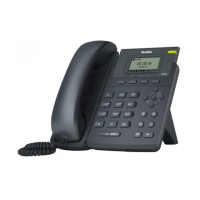Administrator’s Guide for SIP-T2 Series/T19(P) E2/T4 Series IP Phones
108
low-loss, low-latency, low-jitter and assured bandwidth service.
Assured Forwarding PHB -- defines a method by which BAs (Bandwidth Allocations) can
be given different forwarding assurances.
Default PHB -- specifies that a packet marked with a DSCP value of “000000” gets the
traditional best effort service from a DS-compliant node.
VoIP is extremely bandwidth and delay-sensitive. QoS is a major issue in VoIP implementations,
regarding how to guarantee that packet traffic not be delayed or dropped due to interference
from other lower priority traffic. VoIP can guarantee high-quality QoS only if the voice and the
SIP packets are given priority over other kinds of network traffic. IP phones support the DiffServ
model of QoS.
Voice QoS
In order to make VoIP transmissions intelligible to receivers, voice packets should not be
dropped, excessively delayed, or made to suffer varying delay. DiffServ model can guarantee
high-quality voice transmission when the voice packets are configured to a higher DSCP value.
SIP QoS
SIP protocol is used for creating, modifying and terminating two-party or multi-party sessions.
To ensure good voice quality, SIP packets emanated from IP phones should be configured with
a high transmission priority.
DSCPs for voice and SIP packets can be specified respectively.
Note
Procedure
QoS can be configured using the following methods.
Central Provisioning
(Configuration File)
Configure the DSCPs for voice
packets and SIP packets.
Parameters:
static.network.qos.rtptos
static.network.qos.signaltos
Configure the DSCPs for voice
packets and SIP packets.
Navigate to:
http://<phoneIPAddress>/servlet?p
=network-adv&q=load
For voice and SIP packets, the IP phone obtains DSCP info from the network policy if LLDP
feature is enabled, which takes precedence over manual settings. For more information on LLDP,
refer to LLDP on page 66.

